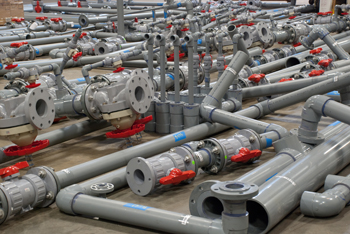Piping fabrication involves the assembly and construction of pipes to create a network or system for the transportation of fluids, gases, or other materials within an industrial facility. Here are some details about piping fabrication:
1. Material Selection:
Pipe Material: Common materials include carbon steel, stainless steel, alloy steel, PVC, and various other alloys. The selection depends on factors such as the type of fluid, temperature, pressure, and environmental conditions.2. Pipe Cutting:
Methods: Pipes are cut to the required lengths using various methods, including sawing, flame cutting, or specialized pipe cutting machines. Beveling: The pipe ends may be beveled for welding preparation.
3. Pipe Welding:
Welding Processes: Welding is a crucial part of piping fabrication. Common welding processes include: Shielded Metal Arc Welding (SMAW) Gas Tungsten Arc Welding (GTAW) Gas Metal Arc Welding (GMAW) Flux-Cored Arc Welding (FCAW) Welding Joints: Common types of joints include butt joints, socket welds, and fillet welds.4. Pipe Fitting:
Types of Fittings: Fittings like elbows, tees, reducers, and flanges are used to connect and change the direction of pipes. They can be threaded, socket-welded, or butt-welded. Alignment: Proper alignment and fit-up are essential for the integrity of the piping system.5. Pipe Supports:
Hangers and Supports: These are installed to support the weight of the pipes and maintain proper alignment. They prevent sagging or excessive stress on the piping system.6. Inspection and Testing:
Visual Inspection: The fabricated piping undergoes visual inspection to ensure weld quality, proper fit-up, and adherence to specifications. Non-Destructive Testing (NDT): Methods like ultrasonic testing, radiography, and dye penetrant testing may be employed to identify potential defects. Pressure Testing: Piping systems are often pressure-tested to ensure they can handle the intended service conditions without leaks.7. Surface Treatment:
Painting or Coating: Pipes may be painted or coated to protect against corrosion and environmental conditions.8. Documentation:
As-Built Drawings: Once the fabrication is complete, accurate as-built drawings are created, documenting the exact location and specifications of each pipe in the system.9. Installation:
On-Site Installation: Fabricated pipes are transported to the site, and the installation involves connecting them according to the designed layout. Welding at Site: In some cases, additional welding may be required on-site to connect fabricated sections.10. Quality Control:
Quality Assurance (QA) and Quality Control (QC): Rigorous quality control measures are implemented throughout the fabrication process to ensure compliance with industry standards and project specifications. Piping fabrication is a complex process that requires precision, adherence to standards, and attention to detail. The quality of the fabrication process directly impacts the efficiency, safety, and longevity of the overall piping system. It is often carried out by specialized fabrication shops or contractors with expertise in piping systems.